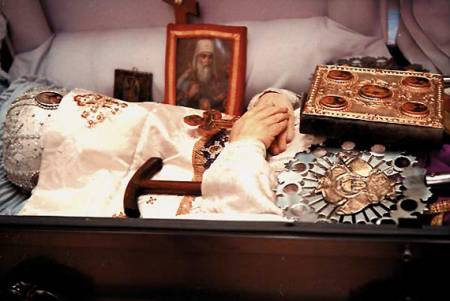On the Persecution of St. John Maximovitch
 |
| Tomb of St. John Maximovitch of Shanghai and San Fransisco, Holy Virgin Russian Orthodox Cathedral, San Fransisco, California, United States of America |
In 1962, at the request of the allies of St. John Maximovitch, who rescued by him from Shanghai the years before, he was commissioned to head the Diocese of San Francisco as Archbishop. After this, the local Russian community suffered a deep schism. Supporters of the former Archbishop completely paralyzed the construction of the cathedral, based on their own selfish interests and rebellious spirit.
With the arrival of Archbishop John, there was a hope that he would be able to contribute peace to the affairs of the Russian community and resume the construction of the temple. And indeed, the arrival of the blessed Archbishop pushed the matter out of a dead end, donations flowed abundantly, construction resumed. But there was no peace.
A part of the bishops rebelled against St. John, who terribly hated him for his openness and kindness. He alone was the obvious successor to the seriously ill First Hierarch Anastasia (Gribanovsky). The bishops were determined to defame him in any way possible. Passions in the Russian colony burned to the limit. The spiritual children of the enemies of St. John fell furiously on the blessed one. He was insulted right in the temple. One woman, just a child at the time, recalled the incident that struck her to the depths of her soul:
“I was with my mother, and she and other women ran after Lord John, cursed him and spat after him. I saw my mom spit in his face! ”
"I don't understand why people suddenly hated him," her sister replied to this woman, "We, children, felt that he was innocent." We understood each other, he loved us... ”
The hierarchs, led by Archbishop Vitaly (Ustinov), a limited man with narrow thinking and deep hatred for the Moscow Patriarchate, accused St. John of having secretly served the interests of the Moscow Patriarchy, which he commemorated at the liturgy together with Metropolitan Anastasy and Patriarch of Moscow Alexiy I.
As many as two hundred and fifty plaintiffs filed against him together in two courts - spiritual and secular. In front of the Church, he was also accused of venerating foreign and unlawful saints - Blessed Augustine and other ancient Western saints of undivided Christianity. They also said that he was a communist, although there was open envy behind it. After all, thousands of people around the world respected Archbishop John as a living saint.
During these troubled days, St. John even wrote in the hearts of one of his spiritual chads: "If you hear that I died, know that I was killed."
St. John was also accused of embezzlement, dragged into court, where aggressive American lawyers began to pour streams of blatant slander upon him. The judge, an old Irishman, assessed the situation as soon as he saw Saint John and understood his character, For the first time in the San Francisco court history, he was allowed to say a prayer before each hearing. Naturally, the plan to condemn St. John failed. But he was not left alone, the first trial followed by the second and so on. They killed him deliberately...
The new thorn of contention became St. John's connection with the Western Rite and his consecrations of bishops in that rite. Eugraph Kovalevsky with the name of “John-Nectarius,” in honor of St. John of Kronstadt and Saint Nectarios of Aegina, who St. John had elevated to the role of bishop in the newly establish French Western Rite Church. Despite the permission granted by the highest authority of the ROCOR to perform this consecration, the ordering of Eugraph as a bishop became one of the reasons for the temporary suspension of St. John from the management of the diocese. The saint was judged by the court of the Archbishop's Synod of the ROCOR, which, however, finally justified him.
Nevertheless, the head of the Western European Diocese of the ROCOR, Bishop Anthony (Bartoshevich) said that he did not recognize the episcopal consecration of Kovalevsky, and refused to contact the parishioners of the Western Rite.
The enemies of the Saint have eventually achieved their goal. The saint died on July 2, 1966, in a prayer before the miraculous icon of the Kursk-Korenna Mother of God. His death united the divided San Francisco community at last. As if suddenly the illuminated, people were gathering to the coffin. Almost everyone cried, the friend of St. John Archbishop Leontius of Chile cried like a child. Later he will say of the death of the blessed John: “One of the last true apostles has left the earth. Who will take his place now? ”
At the foot of the coffin lay Archimandrite Spyridon, a wonderful Russian monk. No warnings or prayers had helped. He lamented for St. John. At some point this man, known for all his meekness and eternal kind smile on his face, suddenly rose up and, turning to the gathered people, cried out that he had strength: "You killed him! You have murdered a righteous man!”
The spiritual children of the Lord, those orphan children whom he saved in Shanghai, carried his coffin three times around the cathedral, which the Lord managed to build before he died.
At the end, Archbishop Leontius smiled brightly during the funeral and said: "Now we have our own saint!”
 |
| The Incorrupt Body of St. John Maximovitch |


Comments
Post a Comment